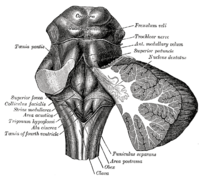
Photo from wikipedia
Alzheimer's disease is histopathologically well defined by the presence of amyloid deposits and tau‐related neurofibrillary tangles in crucial regions of the brain. Interest is growing in revealing and determining possible… Click to show full abstract
Alzheimer's disease is histopathologically well defined by the presence of amyloid deposits and tau‐related neurofibrillary tangles in crucial regions of the brain. Interest is growing in revealing and determining possible pathological markers also in the cerebellum as its involvement in cognitive functions is now well supported. Despite the central position of the Purkinje cell in the cerebellum, its electrophysiological behaviour in mouse models of Alzheimer's disease is scarce in the literature. Our first aim was here to focus on the electrophysiological behaviour of the cerebellum in awake mouse model of Alzheimer's disease (APPswe/PSEN1dE9) and the related performance on the water‐maze test classically used in behavioural studies. We found prevalent signs of electrophysiological alterations in both Purkinje cells and deep cerebellar nuclei neurons which might explain the behavioural deficits reported during the water‐maze test. The alterations of neurons firing were accompanied by a dual (~16 and ~228 Hz) local field potential's oscillation in the Purkinje cell layer of Alzheimer's disease mice which was concomitant to an important increase of both the simple and the complex spikes. In addition, β‐amyloid deposits were present in the molecular layer of the cerebellum. These results highlight the importance of the output firing modification of the AD cerebellum that may indirectly impact the activity of its subcortical and cortical targets.
Journal Title: European Journal of Neuroscience
Year Published: 2022
Link to full text (if available)
Share on Social Media: Sign Up to like & get
recommendations!